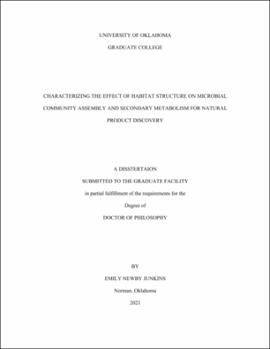| dc.description.abstract | Microorganisms exist in dynamic networks that catalyze reactions and respond to stimuli. They organize into populations that make up the microbial communities we know to drive large-scale biogeochemical cycles that can determine the fate of all organisms in an ecosystem. For something so minute, their impact is extensive. What culminates in global-scale processes starts with the small interactions microorganisms have with their environment, and importantly, each other.
Microbial communities are dynamic systems; one of the most intricate traits of a microbial community is the interactions taking place among its members. Consider a microbial community a small neighborhood, where interactions define the network and structure of a community. Many of these interactions are mediated by secondary metabolites as these are the molecules microorganisms use to communicate and compete. Because of these bioactive roles, microbial secondary metabolites represent promising antimicrobial drug targets, and their structures make up a large proportion of our current antibiotics on the market. The diversity of secondary metabolites in the microbial world is promising, as the increase in antimicrobial resistance among pathogens has intensified the need for new drugs and strategies.
With advances in high throughput sequencing and metabolomic methods, research efforts continue to characterize the untapped biosynthetic potential of microbial communities as they interact with each other and the environment. Considering the network in which communities assemble and interact, this dissertation sought to leverage the ecology behind the production of secondary metabolites in an effort to cultivate antimicrobial producers. Since microbes exist in structured environments, we aimed to characterize the effect of habitat structure on the production of secondary metabolites. We hypothesized that manipulating the habitat during cultivation may select for more competitive interactions as organisms compete for space and nutrients, potentially producing secondary metabolites as a means to be successful.
This dissertation showed that manipulating the interaction landscape of a microbial community can alter the microbial community assembly patterns and the chemodiverisity in structured habitats. These studies add to continuing efforts to (1) characterize the drivers of microbial community assembly, (2) associated changes in microbial diversity with chemical diversity, and (3) determine cultivation methods that select for diverse microbial assemblages and that elicit a secondary metabolic response for both natural product discovery and chemical ecology. | en_US |
